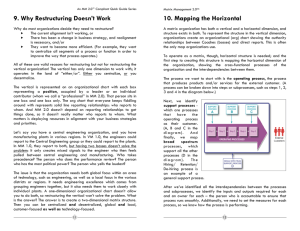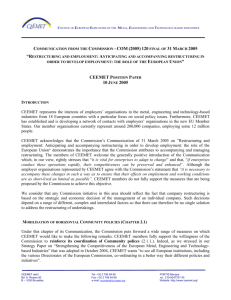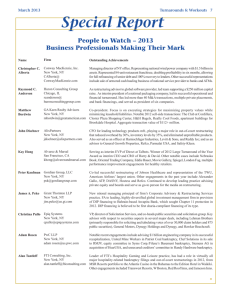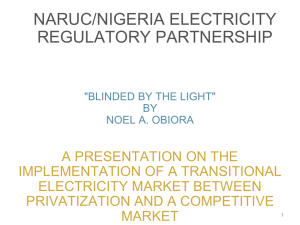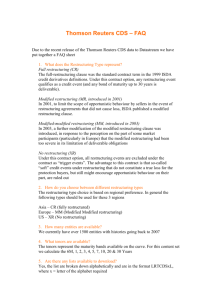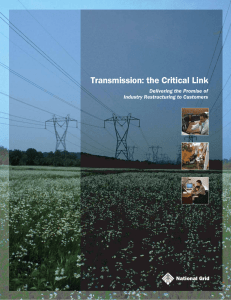Directive 96/92/EC concerning common rules for the
advertisement
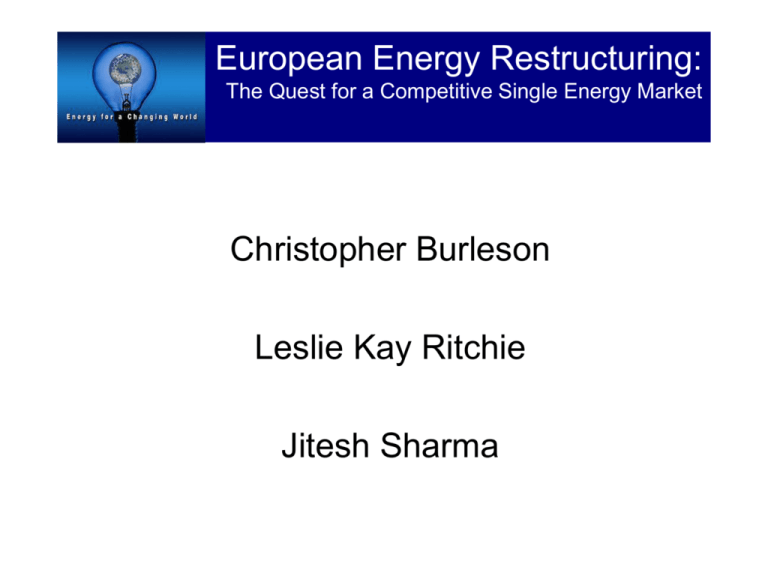
European Energy Restructuring: The Quest for a Competitive Single Energy Market Christopher Burleson Leslie Kay Ritchie Jitesh Sharma European Energy Restructuring: The Quest for a Competitive Single Energy Market Presentation: 1. 2. 3. 4. Overview of EU and Restructuring Vision Comparison of European Restructuring to U.S. Restructuring Timeline: Implementation of EU Directives & Description of EU Energy Stakeholders Impediments to Single Market & Recommendations European Energy Restructuring: The Quest for a Competitive Single Energy Market • EU Vision: – To liberalize the electricity markets into a single, internal competitive model European Energy Restructuring: The Quest for a Competitive Single Energy Market • The EU has determined three objectives for a comprehensive European energy policy: – (1) combating climate change – (2) promoting jobs and growth, – (3) limiting the EU's external vulnerability to gas and oil imports. – News Release, An energy policy for Europe: Commission steps up to the energy challenges of the 21st Century, 10 January 2007. 27 Member States of the EU 1958 Belgium, France, (West) Germany, Italy, Luxembourg, Netherlands 1973 Denmark, Ireland, UK 1981 Greece 1986 Portugal, Spain 1995 Austria, Finland, Sweden 2004 Cyprus, Czech Republic, Estonia, Hungary, Latvia, Lithuania, Malta, Poland, Slovakia, Slovenia 2007 Romania The EU’s “Institutional Triangle” European Parliament: represents the EU’s citizens and is directly elected by them Council of the European Union: European Commission: represents the individual member states seeks to uphold the interests of the whole Union European Regulators' Group for Electricity and Gas: advisory body on internal energy market issues. Comparative Study: U.S. vs. European Restructuring Models • U.S. Electric Power Markets (clockwise from top) – – – – – – – – – – Northwest Midwest New York New England PJM (Beige) Southeast SPP ERCOT Southwest California Comparative Study: U.S. vs. European Restructuring Models European Energy Restructuring: The Quest for a Competitive Single Energy Market Similarities between Europe & U.S. Restructuring • Both Driven by Top-Down Political Maneuvering • Both Protect Against Price Volatility • Both Work to Ensure Sufficient Energy Capacity European Energy Restructuring: The Quest for a Competitive Single Energy Market Differences between Europe & U.S. Restructuring • Structure of Market • Infrastructure/Transmission Management • Relative Capability of Facilitating Restructuring • Comparative Success of Response to Transmission Discrimination Liberalisation process – Timeline 1996 2003 Source: Union of the Electricity Industry, Eurelectric 2007 20?? Liberalisation process – Timeline Cross Border Trade Regulation Effective Florence Forum European Regulators Group for Electricity & Gas 1st Electricity Directive: 96/92/EC CEER 1996 1998 2003 2nd Electricity Directive: 2003/54/EC 2004 2005 Directive on Electricity Security of Supply and Infrastructure European Energy Restructuring: The Quest for a Competitive Single Energy Market Key Indicators – Single market not working • Significant price differences prevailing in the internal markets – Price difference of more than 100% for industrial users in some cases • Low level of cross border trades – Cross border flows was at 10.7% of consumption at the end of 2004 – Increased only by 2% in 4 years • Prices have been increasing instead of decreasing as part of increased competition in the market • Lack of real competition – Switching by customers remains limited in most Member States – Choosing a new supplier from another Member State remains the exception Key Indicators – Single market not working Prices in different regions Market share of biggest three producers Key Indicators – Single market not working Impediments for single market • Insufficient interconnection between many Member States, leading to congestion • Concentration and consolidation in the industry – • Independence of network operators – • Vertical integration between generation and retail markets long term power purchase agreements lead to illiquid wholesale markets. Lack of transparency – – • There is an inadequate unbundling between network and supply activities Vertical foreclosure – – • Number of newcomers has decreased Survey shows that 84% people feel that they do not have current market information Only a few TSOs publish all information related to network access and availability Lack of FERC like regulatory authority Impediments for single market • Insufficient interconnection between many Member States, leading to congestion • Concentration and consolidation in the industry – • Independence of network operators – • Vertical integration between generation and retail markets long term power purchase agreements lead to illiquid wholesale markets. Lack of transparency – – • There is an inadequate unbundling between network and supply activities Vertical foreclosure – – • Number of newcomers has decreased Survey shows that 84% people feel that they do not have current market information Only a few TSOs publish all information related to network access and availability Lack of FERC like regulatory authority What should be done? • Investments in electricity generation and infrastructure • Separate supply and production activities from network operation – Require strong national regulators to oversee the running of electricity and gas markets • Establish an independent mechanism for cooperation and governance among national regulators (FERC-like authority) • Greater transparency in energy market operations – Create mechanism for transmission system operators to improve coordination of networks operation. European Energy Restructuring: The Quest for a Competitive Single Energy Market Thank you! Questions?

